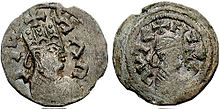User:Theycallmezeal/sandbox
Aksumite settlers in Himyar
[edit]
The Kingdom of Aksum was an ancient empire in what is now northern Ethiopia. There were four invasions and subsequent settlements of Aksumites in Himyar, located across the Red Sea in modern-day Yemen. These invasions and settlements led to one of the first large-scale African diasporas in the ancient world.
In 517 AD, the Himyarite king Ma’adikarib was overthrown by Dhu Nuwas, a Jewish leader who began persecuting Christians[1] and confiscating trade goods between Aksum and the Byzantine Empire[2], both of which were Christian nations.[3] A man identified as Bishop Thomas journeyed to Aksum to report on the persecution of Christians in Himyar to the Aksumite Kingdom.[4] As a result, the Aksumite king Ahayawa invaded Himyar.[5] Dhu Nuwas fled this first invasion[6], and at least 580 Aksumite soldiers remained in Himyar.[7] Himyarites who opposed Aksumite settlement united under Dhu Nuwas[8], and the formerly expelled king traveled back to kill the Aksumite soldiers and continue the oppression of Christians, forcing some settlers back into Aksum.[9]

In response to Dhu Nuwas’s Christian persecution, the new Aksumite king Kaleb first sent a group of Himyarite refugees in his Aksumite kingdom back into Himyar to stir up underground resistance against Dhu Nuwas. These discontented Himyarites then united under nobleman Sumyafa Ashwa[10]. Kaleb successfully invaded Himyar with an Aksumite army in 525 and installed Sumyafa Ashwa to rule.[11] [12] More Aksumite soldiers remained in Himyar to claim land.[13] The Byzantine ruler Justinian learned of this development and sent an ambassador, Julianus, to ally Aksum and Himyar with the Byzantine Empire against Persia. The overtures made by the Byzantine Empire to influence Himyar demonstrate that the Aksumite settlers in Himyar, due to their sustained residence and political organization, constituted a “stable community in exile,” which historian Carlton Wilson deems a necessary condition to classify a settlement as a diaspora.[14] Justinian had two wishes for this proposed alliance: first, for Aksum to purchase and distribute Indian silk to the Byzantine Empire to undermine Persia economically, and second, for Aksum-ruled Himyar to invade Persia, led by the general Caisus. Both of these plans failed, as Persia’s proximity to India made the interruption of their silk trade impossible, and neither Himyar nor Aksum saw value in attacking an adversary that was both stronger and far too distant. Caisus was also responsible for killing a relative of Sumyafa Ashwa’s, making Aksumites unwilling to go into battle under him.[15]
A third invasion was prompted by a rebellion of Aksumite soldiers between 532 and 535[16], led by the former slave[13] and Aksumite commander[16] Abreha, against Sumyafa Ashwa. Kaleb sent 3,000 soldiers to quell this rebellion, led by one of his relatives, but these soldiers joined Abreha’s rebellion upon arrival and killed Kaleb’s relative. Kaleb sent reinforcements in another attempt to end the rebellion, but his soldiers were defeated and forced to turn around. Following Kaleb’s death, Abreha paid tribute to Aksum to reinforce Himyar’s independence.[13] The new Himyarite nation consisted of several thousand Aksumite emigrants, serving as one of the earliest examples of a large-scale movement of tropical Africans outside of the continent. Just a century later, Aksum’s relationship to this southwestern part of the Arabian peninsula would be pivotal to the introduction of Islam at Mecca and Yathrib (Medina), as evidenced by the the naming of Bilal[17], an Ethiopian[18], as the first muezzin, and the flight of some of Muhammad's earliest followers from Mecca to Askum.[19]
- ^ "73. The Conversion of the People of Najrân". The Chronicle of Seert. Translated by Alcock, Anthony. 2014.
- ^ Kobishchanov, Yuri M. (1990). Axum. University Park, Pennsylvania: Penn State University Press. p. 91. ISBN 0271005319.
- ^ Procopius (1914). Procopius, with an English translation by H. B. Dewing. Vol. 1. Translated by Dewing, Henry Bronson. London: William Heinemann. pp. 189, 193.
- ^ Moberg, Axel, ed. (1924). The book of the Himyarites : fragments of a hitherto unknown Syriac work. Lund : C.W.K. Gleerup. p. ci.
{{cite book}}: CS1 maint: ref duplicates default (link) - ^ Moberg (1924), pp. ci. Some sources (e.g. Acta Sanctorum) indicate that the king at this time was not Ahayawa, but Kaleb; other sources (e.g. Procopius) begin with the second invasion led by Kaleb.
- ^ Acta Sanctorum. Brussels. 1861. Octobris X, index chronologicus, saeculo VI.
{{cite book}}: CS1 maint: location missing publisher (link) Cited in Kobishchanov (1990), p. 91. (The Tapharis named in Acta Santorum is Zafar, Yemen.) - ^ Moberg (1924), pp. ci–cii, cv. Page ci establishes that the first presence of Aksumites (Abyssinians) in Himyar was due to Ahayawa’s (HWYN’) invasion. Page cv indicates that Dhu Nuwas (Masrūq) killed 300 Aksumite soldiers on one occasion and 280 on another, leading to the conclusion that at least 580 Aksumite soldiers were in Himyar. Page cii shows that these killings happened soon after Ahayawa’s invasion, suggesting that the 580 Aksumite soldiers were part of the invasion.
- ^ Kobishchanov 1990, p. 92.
- ^ Moberg 1924, pp. cii.
- ^ Kobishchanov 1990, p. 100.
- ^ Procopius 1914, p. 189.
- ^ Moberg 1924, pp. cxlii, cxxxiv–cxxxv.
- ^ a b c Procopius 1914, p. 191.
- ^ Wilson, Carlton (1997). "Conceptualizing the African Diaspora". Comparative Studies of South Asia, Africa and the Middle East. 17 (2): 118–122. doi:10.1215/1089201X-17-2-118.
- ^ Procopius 1914, p. 193.
- ^ a b Kobishchanov 1990, p. 105.
- ^ Arafat, W. "Bilа̄l b. Rabа̄ḥ". Encyclopaedia of Islam, Second edition. Isḥа̄q (1998). The Life Of Muhammad. Karachi: Oxford University Press. pp. 143–144.
- ^ Isḥа̄q 1998, pp. 235–236.
- ^ Sīrat ibn Hishа̄m (2000). M. Hа̄rūn, ’Abdus-Salа̄m (ed.). Biography of the Prophet. Cairo: Al-Falah Foundation for Translation, Publication and Distribution.

